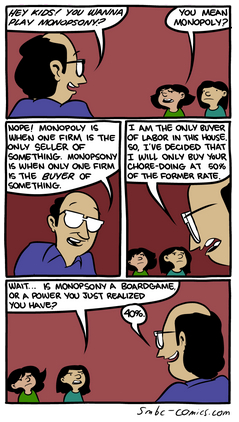No, we don’t mean monopoly. A monopoly is the single seller in a large or small geographic area. Monopsony, by contrast, indicates there is a single buyer.

Where are we going? Whereas a monopoly has the power to charge too high a price, the amount a monopsony pays to its suppliers is too low. As a result, like monopolies, they are inefficient users of land, labor and capital.
Comcast’s pending acquisition of Time Warner Cable is an example of why monopsonies are worrisome. Not yet approved by the Justice Department, a merger of Comcast with 21.6 million subscribers and Time Warner Cable with 11.4 million would create a more concentrated competitive market structure. As the 2 largest cable companies in the US, combined, they would control close to 30% of the market and have the power to offer suppliers of programming like Walt Disney an excessively low price. From the supply side, Disney then has the incentive to provide less programming. And even if Disney said okay, the monopsony would probably not pass along its savings to us.
Until the beginning of 1976, when baseball players were no longer prohibited from negotiating elsewhere because of the reserve clause, team owners ran monopsonies. Some say public school teachers work for a monopsony because there is only one local school district. Others see company towns where there is one employer as a monopsony.
You can see below the markets in which monopsony creates a gap–called the “rate of exploitation”– between the wage that is paid and the market wage.

Our bottom line? A firm’s competitive market structure shapes its behavior. For monopsony, that means excessive control of suppliers–who could be other producers or labor–and inefficiency.
Do you think the Comcast/Time Warner Cable Deal should proceed? Please let us know in a comment.
Why Mickey Mouse Worries About Monopsonies

Elaine Schwartz
Elaine Schwartz has spent her career sharing the interesting side of economics. At the Kent Place School in Summit New Jersey, she was honored with an Endowed Chair in Economics. Just published, her newest book, Degree in a Book: Economics (Arcturus 2023), gives readers a lighthearted look at what definitely is not “the dismal science.” She has also written and updated Econ 101 ½ (Avon Books/Harper Collins 1995) and Economics: Our American Economy (Addison Wesley 1994). In addition, Elaine has articles in the Encyclopedia of New Jersey (Rutgers University Press) and was a featured teacher in the Annenberg/CPB video project “The Economics Classroom.” Beyond the classroom, she has presented Econ 101 ½ talks and led workshops for the Foundation for Teaching Economics, the National Council on Economic Education and for the Concord Coalition. Online for more than a decade. econlife has had one million+ visits.





